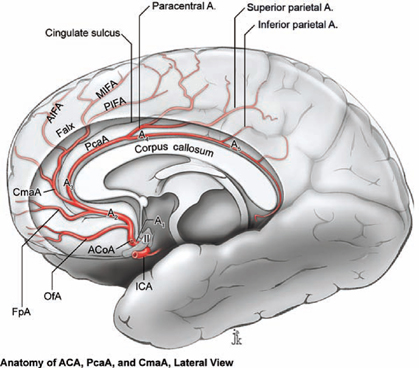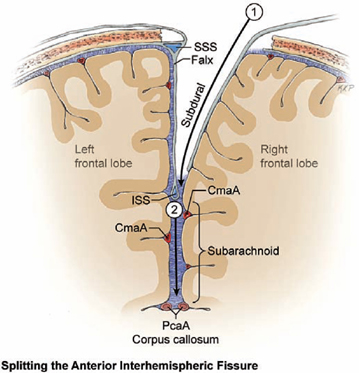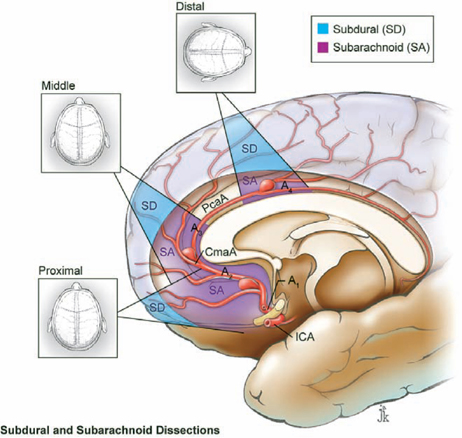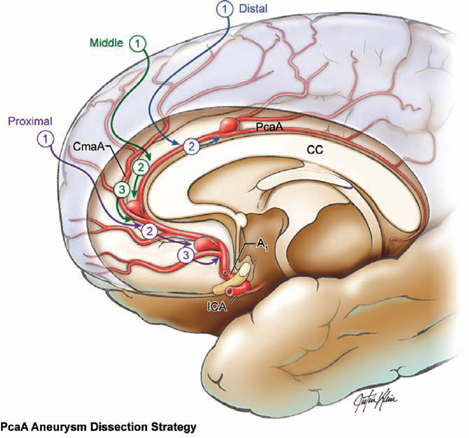18 Pericallosal Artery Aneurysms The anterior cerebral artery (ACA) distal to the anterior communicating artery (ACoA) is divided into four segments (Fig. 18.1). The A2 segment, also called the post-communicating or infracallosal segment, begins at the ACoA and follows the rostrum of the corpus callosum; the A3 segment, or precallosal segment, curves around the genu until the artery assumes a posterior course; the A4 segment (supracallosal) and A5 segment (postcallosal) continue over the anterior and posterior halves, respectively, of the body of the corpus callosum, the division between them being the vertical plane of the coronal suture. The ACA’s ascending segment consists of A2 and A3, and its horizontal segment consists of A4 and A5. The bifurcation into the pericallosal and callosomarginal arteries does not define these distal segments. Its location varies from just distal to the ACoA to the genu, and is most often in the A3 segment. The callosomarginal artery (CmaA) may be absent in 20% of patients. The pericallosal artery (PcaA) lies on top of the corpus callosum, whereas the callosomarginal artery courses in or near the cingulate sulcus, one gyrus above the corpus callosum and parallel to the PcaA. The PcaA and CmaA are the two largest distal ACA branches, and their calibers are inversely related. The PcaA is usually bigger than the CmaA. All of the PcaA runs below the free margin of the falx, whereas only the anterior portion of the CmaA does. Fig. 18.1 Microsurgical anatomy of the anterior cerebral artery, ACA, pericallosal artery (PcaA), and callosomarginal artery (CmaA) (lateral view). The ACA is divided into five segments: A1, precommunicating or horizontal segment; A2, post-communicating or infracallosal segment; A3, precallosal segment; A4, supracallosal segment; and A5, postcallosal segment. ACA, PcaA, and CmaA have eight major cortical branches: orbitofrontal, frontopolar, internal frontal (anterior, middle, and posterior), paracentral, and parietal (superior and inferior) arteries. ACoA, anterior communicating artery; AIFA, anterior internal frontal artery; FpA, frontopolar artery; ICA, internal carotid artery; MIFA, middle internal frontal artery; OfA, orbitofrontal artery; PIFA, posterior internal frontal artery. Eight cortical branches are typically observed: orbitofrontal, frontopolar, internal frontal (anterior, middle, and posterior), paracentral, and parietal (superior and inferior) arteries (Fig. 18.1). The orbitofrontal and frontopolar arteries originate from the A2 segment and are more relevant to ACoA aneurysms, where they can drape the aneurysm dome and appear as false trunks. The anterior internal frontal artery (AIFA), the middle internal frontal artery (MIFA), and the callosomarginal arteries originate from the A3 segment; the paracentral artery originates from the A4 segment; and the superior and inferior parietal arteries originate from the A5 segment. The posterior internal frontal artery (PIFA) can arise from the A3 or A4 segments. The branching pattern of the distal ACA is highly variable, and these branches provide little anatomic guidance during the fissure dissection. These cortical branches extend over the convexity to supply the superomedial surfaces of the hemisphere, anastomosing laterally with the middle cerebral arteries and posteriorly with the posterior cerebral arteries in watershed areas. Anomalies of the distal ACA include triplication of the A2 segments (accessory A2 segment), an unpaired A2 segment (azygos ACA), and a bihemispheric ACA (an ACA that supplies both hemispheres). The anterior interhemispheric fissure is opened widely with PcaA aneurysms, separating the medial frontal lobes along the corridor down to the aneurysm. Bifrontal craniotomy, dural opening in a flap based along the superior sagittal sinus (SSS), and dural reflection to the opposite side with taut tacking sutures access a subdural plane down the falx from the SSS to the inferior sagittal sinus (ISS), obstructed only by some arachnoid granulations and adhesions that are easily released (Fig. 18.2, step 1). Bridging veins and veins that fuse with the parasagittal dura before reaching the midline can be more problematic. Fused or intradural veins can be preserved by splitting the dural flap and creating a dural sleeve over the vein; bridging veins can be preserved by maximizing working spaces between them. Fig. 18.2 Opening the anterior interhemispheric fissure involves subdural dissection between the falx and the medial right frontal lobe (step 1), and subarachnoid dissection between the medial frontal lobes through the corpus callosum cistern (step 2). Arterial branches are followed in this subarachnoid plane to deepen the dissection down to the corpus callosum and the paired PcaAs. ISS, inferior sagittal sinus; SSS, superior sagittal sinus. Subdural dissection transitions to subarachnoid dissection beneath the free edge of the falx at the roof of the posterior corpus callosum cistern (Fig. 18.2, step 2). This cistern is entered in the midline, looking for one of the ascending branches from the CmaA. The cortical surfaces of the medial frontal lobes can be tightly opposed and adherent, and the technique for opening the interhemispheric fissure is the same as for splitting the sylvian fissure. A peripheral artery is followed deeper and deeper to larger trunks using a combination of sharp and spreading dissection (Fig. 18.3, step 1). However, the corpus callosal cistern does not widen as the dissection deepens, as the sylvian cisterns do with sylvian fissure splitting. In addition, the caliber of the ACA branches does not enlarge the way that MCA branches enlarge to separate the sylvian surfaces of the frontal and temporal lobes. Subarachnoid hemorrhage, interhemispheric hematoma, and secondary brain swelling can make brain tissue friable, making this separation of frontal lobes without pial transgression challenging. The PcaA can hide beneath the inferior edge of the cingulate gyrus, but the white color of the corpus callosum signals the arrival at the pericallosal’s depth. The laterality of the PcaA and the CmaA can be unclear when they are encountered unpaired, but each artery sends branches to only one hemisphere, and the direction of these branches indicates the side with which that artery is associated. The PcaA is followed anteriorly to open the interhemispheric fissure from “inside-out” (Fig. 18.3, step 2). The fissure is opened from the depth of the PcaA up to the depth of the CmaA and up further to the falx’s free edge. Dissection progressing from distal to proximal is rarely dangerous with unruptured PcaA aneurysms, but can be with ruptured aneurysms. Therefore, once the dissection plane between the frontal lobes is established posteriorly, dissection shifts anteriorly for proximal control. Low-lying or proximal PcaA aneurysms on the A2 segment have poorly accessible proximal control and require a dissecting trajectory almost along the floor of the anterior cranial fossa (Fig. 18.3). Falx is thinned here and provides minimal separation of the frontal lobes, shortening the subdural and lengthening the subarachnoid dissection distances to the A2 segment (Fig. 18.4). This infracallosal segment often courses anteriorly as it follows the rostrum superiorly, which deepens the point of proximal control past the aneurysm itself. Therefore, the dissection must drop low enough to avoid the dome, which often projects anterosuperiorly into this dissection path. This approach along the axis of the A2 segment causes the infracallosal segment to vanish in the field. High-riding or middle PcaA aneurysms on the A3 segment at the genu have proximal control that is more accessible, as do distal PcaA aneurysms on the supra- and postcallosal (A4 and A5) segments. Some distal PcaA aneurysms are amen able to the lateral head position and gravity retraction of the dependent hemisphere (Fig. 18.4). A wide posterior falx separates the frontal lobes, lengthening the subdural and shortening the subarachnoid dissection distances to the A3 or A4 segment. The more posterior craniotomy brings bridging veins along the SSS into the fore field, and instruments must be navigated through a working corridor between these veins. In addition, distal aneurysms require angling back to reach beyond the craniotomy’s posterior edge. As the falx widens posteriorly, it can sometimes be a point of adhesion on the aneurysm dome or a cause of dissecting aneurysm formation when trauma shears the artery against falx’s free edge. When the ACA segments are paired, the afferent artery is traced to the aneurysm to be sure that the correct artery, not the uninvolved contralateral artery, is prepared for proximal control. Fig. 18.3 Dissection steps for pericallosal artery aneurysms. Step 1, following the peripheral arteries deeper and deeper to split the anterior interhemispheric fissure. Step 2, widening the fissure split by following the PcaA along the corpus callosum (CC). Step 3, shifting the dissection to the aneurysm’s proximal side. Low-lying or proximal PcaA aneurysms require a dissection trajectory almost along the floor of the anterior cranial fossa (purple arrows). High-riding or middle PcaA aneurysms have more accessible proximal control (green arrows). The dissection of distal PcaA aneurysms is already proximal and requires posterior dissection along the ACA to reach the aneurysm (no step 3) (blue arrows).
 Microsurgical Anatomy
Microsurgical Anatomy

 Aneurysm Dissection Strategy
Aneurysm Dissection Strategy


Stay updated, free articles. Join our Telegram channel

Full access? Get Clinical Tree





